Humanode Sybil-resistant quadratic retroactive airdrop

Retroactive airdrops have almost become an industry standard during the latest cycle. We have seen the emergence of a new class of crypto users: tech savvy enthusiasts without deep pockets but active participants of the community choose projects they like and trust, participate in them and get rewarded.
Sybil-farming
However, it has also led to the emergence of drop hunters who will do anything to game the system in order to reap disproportional amounts of rewards. Creating multiple accounts to pretend to be multiple testnet or beta users is called sybil-farming. The most outright example was Ribbon Finance, where even one of the early investors was involved in sybil-farming eventually selling their position for ~2M dollars:
Hey everyone, as you may have seen, one of our investors earned a lot of $RBN through farming our airdrop in May, and sold it for ETH today, for about ~$2mm https://t.co/4od8QhDFoU
— Julian 🤹 (@juliankoh) October 8, 2021
The consequences are:
- Selling pressure from sybil-farmers;
- Lower rewards for real community: testers and early contributors;
- Long-term: lower participation and capitalization of the protocol.
After reviewing these cases some projects even decided to turn tail upon retroactive airdrop for their early users. As a result, the community turned tail upon these protocols.
Introducing sybil-resistant airdrops
To fight malicious farmers we have to ensure there is just one person behind one account. KYC is a time consuming, expensive process, undermining one of the core values of the crypto industry - privacy.
Humanode offers an opportunity to check whether there is a living and unique human being behind a crypto account using the most accurate facial recognition neural networks as well as making the biometric computations private. Only anonymized and encrypted data leaves the user's device while the comparison of biometric data happens in the network of servers encrypted by secure enclaves. The whole process does not take more than a minute and requires only a mobile device with a 3MP frontal camera:

The current error rate which means that the neural network will consider 2 people so similar that it will think it is one person is 1 in 125M. In a few years it is projected to be 1 in 8 billion, same as the number of people on Earth! Cryptobiometrics is so far the only way to fight sybil attacks without compromising user's privacy.
Introducing quadratic airdrops
Modelling the airdrops projects take into account different key parameters:
- blockchains or L2s - number of blocks validated or volume transferred;
- DeFi protocols - volume transferred or put into liquidity pool;
- Games - time spent or actions taken.
Most of the users genuinely interested in the technology will try the tech for a couple of times, however, they won't go full in into a new a new protocol, both time and financially wise. Most likely, those who are engaged in the protocol too much are drop hunters. While there is nothing bad in this, unless they are sybil-farming, regular users are outperformed and left with mere pennies of rewards.
One of the solutions is to introduce quadratic airdrop: take the original KPI of each contribution and calculate a square root out of it. It flattens the curve proportionally increasing the reward of small contributors compared to the largest contributors ensuring everyone gets a fair piece of the pie.
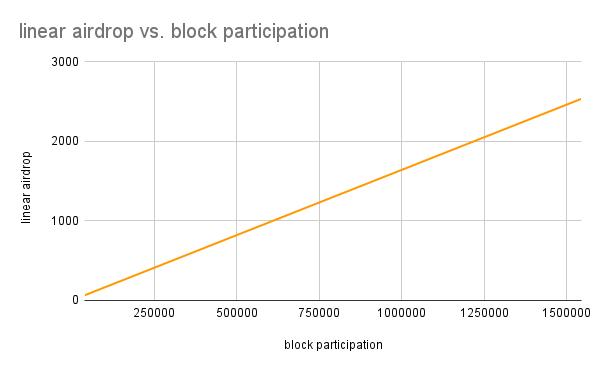
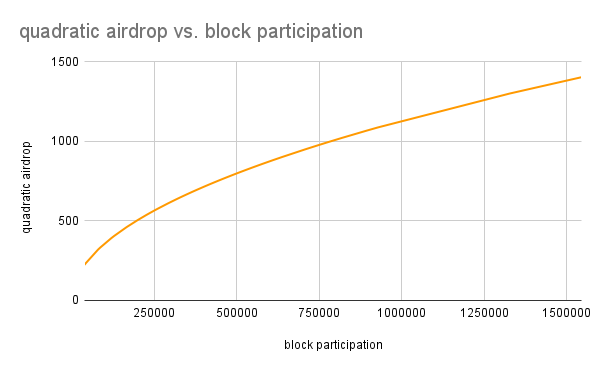
Humanode sybil-resistant quadratic retroactive airdrop
Since September 2021 Humanode team launched 4 testnets of the novel cryptobiometric blockchain based on the notion of one human = one node.
Firstly, in order to fight drop hunters from the very beginning and grow an idea-driven community, it was never announced that the testnets had been incentivized. Hence, a retroactive airdrop.
Secondly, to become a validator the users had to go through biometric checks and make sure they were proposing the blocks (otherwise we could not see them onchain). Moreover, they had to re-scan their face every 3 days! Hence, a sybil-resistant airdrop.
Thirdly, we wanted to ensure that for each user who tested Humanode just once, the reward would have been significantly more than 0 while those who were participating non-stop for almost year the reward would have been a few times higher that their costs of running a node, but not enough to put the HMND markets under high selling pressure.
Fourthly, we randomly assigned a lockup (cliff) for each validator from 0 to 30 days to decrease the selling pressure on the day one.
What we came up with was sybil-resistant quadratic retroactive airdrop.
Calculations
Only participants of the first 3 testnets who were active before the announcements made in August and then mapped their Humanode validator addresses to Ethereum addresses became eligible for the rewards.
Testnet 1 Sachiel had 87 human nodes eligible. If we sum up all the blocks each user participated in we'll have the total of 37,478,332.
Testnet 2 Shamshel lasted over 6 months and had over 10k people launching the nodes, however, only 1151 fulfilled all the requirements. Total block participation - 1,027,096,925.
In the Testnet 3 Ramiel we saw 589 eligible participants taking the snapshot time into account. Total block participation is 153,049,008.
Summing up all the blocks each user participated in we can find out the participation share of each testnet. It was 3%, 84% and 13%, and we divided the testnet validators' allocation respectively.
To calculate the number of tokens for each human node we:
- calculated the square root of the number of blocks one participated in;
- calculated the share of each validator in the sum of square roots;
- multiplied the share of each validator by the number of tokens assigned to each testnet.
Here is the distribution of tokens for each testnet on the graphs:
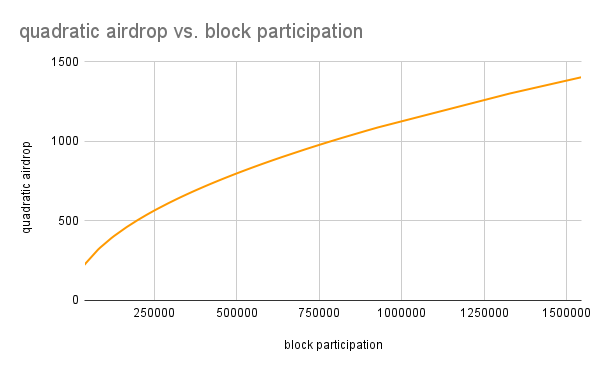
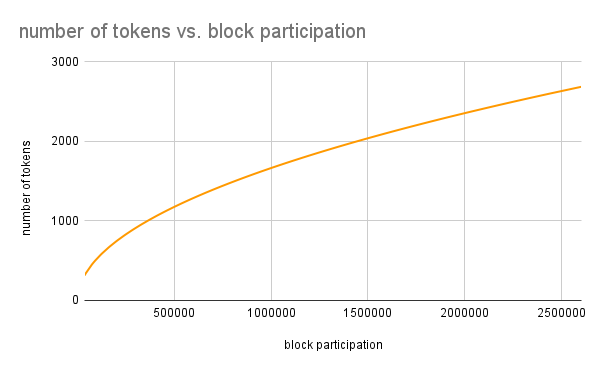
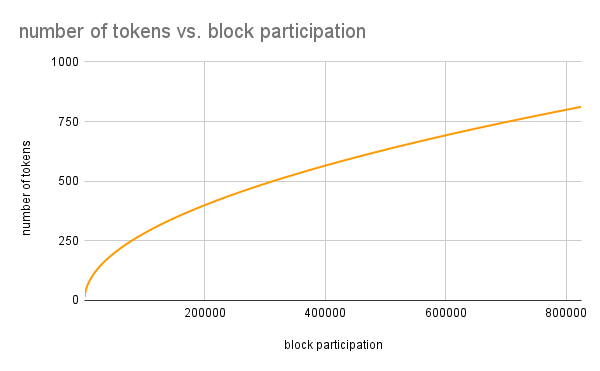
As a result, the least active human node who participated in the consensus only for 19 minutes will get ~12 HMND. The most long running human node ~6 months will get ~2687 HMND.

